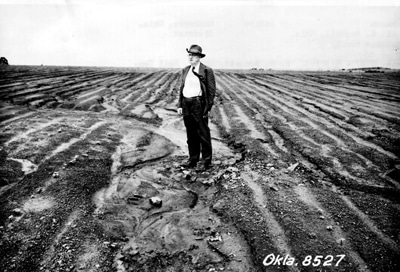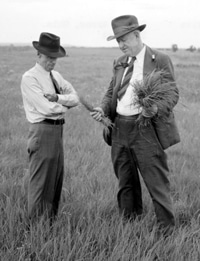We Can Do It!
A Message from Mike Thralls, Conservation Commission Executive Director
March 16, 2009

We have been bombarded day after day with bad economic news. The nation’s economic downturn has made its way to Oklahoma and is affecting our state’s operating budget, including appropriations for conservation districts and the Commission. It appears inevitable that we will have significantly fewer state dollars for conservation in the upcoming fiscal year. On top of that, the Oklahoma Supreme Court voided our $25 million conservation bond issue, forcing us to start all over again with a new bill in this year’s Legislature. It would be easy to get discouraged from all this bad news. But I remain optimistic because I believe in the people involved in Oklahoma’s conservation partnership and their abilities to get the job done.
Those who heard my talk at the OACD state meeting recently know I am reading a book about Hugh Hammond Bennett. Bennett was the father of the soil conservation movement in our country and the first chief of the Soil Conservation Service, today’s Natural Resources Conservation Service. Bennett was the one who through his passion, knowledge and political skills forged the conservation partnership in the 1930s during the bleakest days of the Great Depression and the Dust Bowl. He had an indomitable spirit, a “can do” attitude, and he refused to fail in his goal to successfully address soil erosion.
Even though we face significant economic and conservation challenges today, when compared to what Bennett faced in the 1930s, ours begin to pale. He was starting with nothing and had to build a delivery system from the ground up. Today in Oklahoma we have incredible human and technical resources, in our conservation partnership, that have blossomed since the 1930s. We have 440 dedicated district directors committed to natural resource conservation. We have 181 exceptional conservation district employees and 62 Commission staff — the most talented group in my eleven years with the Conservation Commission. We have 325 highly skilled NRCS employees. In short, rather than talk about the people we need to get the job done, we need to be excited about the quality folks we have that can get the job done!

During these tough budget times I want all of our directors and employees to know that I am personally committed to finding every way possible to keep our operations intact and keep all of our employees in place. We have more federal, state and local conservation programs to deliver than ever before and we need all of our current employees to get the job done. Governor Henry has urged all state agencies to do their very best to avoid furloughs or layoffs in the coming year and here at the Commission I intend to do my very best to meet the governor’s goal.
While we all will be looking at more efficiencies and cost savings in our operations, I am also counting on districts to aggressively explore new partnerships and funding opportunities that can bring new resources into your operations. Think outside the box. At the state meeting I shared several impressive conservation district success stories where new resources were added. I want to encourage all of us to share these success stories with each other so we can get through these tough times together.
And finally I want to encourage districts to pool resources whenever possible to make sure the job gets done. We can no longer put walls around our districts. We need to find ways to share expertise, creativity, equipment and anything else so that our cooperators and our natural resources are served as best we can. We owe it to Hugh Hammond Bennett and to all the conservationists that came before us to get the job done.
When Mr. Bennett was interviewed late in his life, around 1950, he was asked if the severe erosion then occurring around the world caused him great concern. Having come through the Dust Bowl and seeing the positive transformation in our country, he was positive that the global problems could also be solved. His response was “We Can Do It!!!” To all of us I say, “We Can Do It!!!” Together we can get though these hard times and come out stronger on the other side.
